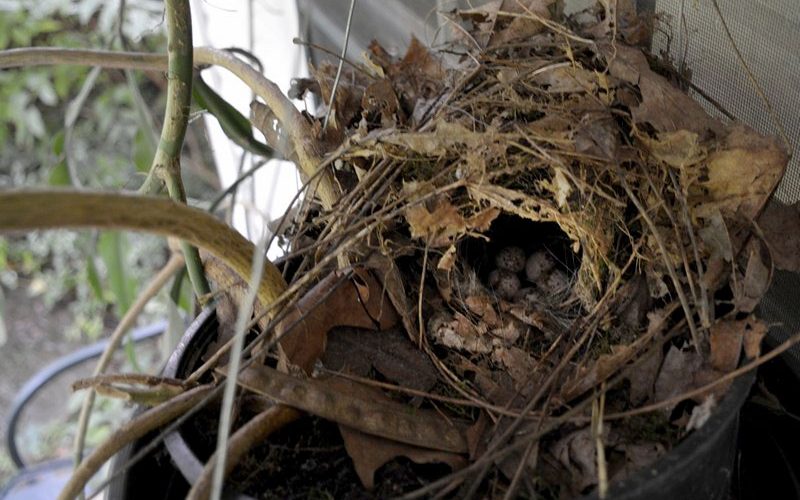Nesting birds make great porch pals

Courtesy Photo
Wrens are creative, flexible nesters, just as happy in a potted plant as in a bird abode.
Wrens and porches just seem to go together. These birds create great entertainment with song, artful nests and home nature programming as they raise their young right before our eyes. In Northwest Arkansas, Carolina wrens are here year-round, but we also see the house wren because we’re in the migration range and on the edge of the breeding range. Carolina wrens have much more defined white eyebrows and buff bellies, while the house wren looks smaller and plainer.
Both species are creative, flexible nesters, and not much seems to discourage them. Cans, boxes, flower pots, old boots, jacket pockets, container herb gardens and even a scooter are up for grabs to a wren. Put out something interesting that you might consider trash, and they will build a beautiful domed nest cup with side entrance leading to roughly five speckled eggs, on average. Males and females build the nest together after the male begins nests in several locations, and the female selects her desired spot from these options.
Mated pairs can have a couple of broods per year. It takes a couple of weeks to incubate the eggs, and a couple more weeks after they hatch for the young to fledge. They’re completely dependent on their parents upon hatching and will not be rejected if you put them back into the nest. Don’t touch fully feathered young hopping about on the ground (unless in immediate danger), because the parents are taking care of it once it leaves the nest and can fly.
What other renter would ever consider eating a cockroach? But wrens do so willingly, also consuming caterpillars, beetles, spiders, crickets and insects, which make up the bulk of their diet. Occasionally, they’ll eat fruits from berry bushes or poison ivy (something’s got to eat it). It’s nice to have built-in bug repellent on one’s porch – although you might have some cleaning up to do once the family flies away.
If you’d like to make your yard more bird-friendly, ensure it provides great habitat to entice them to stay and nest. This includes having a source of fresh water and cover (like a brush pile) to protect them from predators. Native shrubs, trees and grasses can provide seed, fruits, berries and insects. Think height diversity: short wildflowers, medium shrubs and tall trees are better than a flat lawn or a forest of same-age trees. Plant things that will bloom or fruit throughout the year instead of all at once, so birds always have something to eat. Avoiding pesticides helps parents find more insects to feed those hungry fledglings. Installing a nest box can help, but with wrens, they’re not picky renters. Just leave out the welcome mat, and enjoy their company!
Amanda Bancroft is a writer, artist and naturalist building an off-grid cottage for land conservation on Mt. Kessler. She and her husband Ryan blog about their adventures and offer a solar-hosted online educational center on how to make a difference with everyday choices at www.RipplesBlog.org.
Making Ripples
Amanda Bancroft










